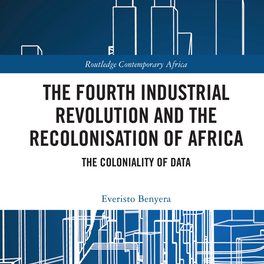Journalism is in the frontline when it comes to keeping governments and business honest, a vital platform in exposing corruption and malfeasance before it can irreversibly rot the health of political systems and civil society. US news organisation The Washington Post has “democracy dies in darkness” emblazoned on its masthead, and this is true of all forms of government, and all forms of democracy.

A representative of Code for Africa, John Eromosele (R), stands on boat while teaching a volunteer, Hannah Shemede (L) how to use the designated computer application to fast-track digital mapping and referencing in the Makoko waterfront settlement in Lagos, on October 23, 2019. Photo: Pius Ekpei/AFP
It’s a truism that for democracy to come to pass, the act of voting should be free and informed. If citizens don’t have the information to make informed choices, the very idea of democracy is subverted. Even worse, false or misleading information can be used to manipulate voters and achieve non-democratic ends. In countries where the problem isn’t a lack of access to information, but rather a deluge of misinformation and disinformation, sorting out good data from bad data is a challenge. In other countries, where data is hard to come by and difficult to verify, we can update The Washington Post’s aphorism to “democracies die in data darkness”.
Data – clean, reliable, machine-readable data – is the essential fuel that keeps civil society ticking over. Crucially, this is not just data as information, but data as actionable information. Citizens, journalists and other interested parties must be able to use the data to make an intervention, and ultimately make a positive contribution to society, and to their own lives. Access to data also varies dramatically in different countries and regions in Africa.
One of the first problems facing data-driven journalists from civil society organisations is getting actual, clean data with which to work. The next step is putting that data in front of citizens, in the form of tools or media projects, so that they can use it in various ways. Then, and perhaps most importantly, is the process of making sure that the data stays fresh and doesn’t lose relevance over time.

Jeje Aide Albert, a Makoko community leader, looks on as officials from Code for Africa engage in digital mapping of the Makoko waterfront fishing settlement in Lagos, on 23 October 2019. Photo: Pius Ekpei/AFP
One example of how this can be accomplished is Map Makoko, a Code for Africa (CfA) project supported by Humanitarian OpenStreetMap and the Pulitzer Center on Crisis Reporting. Makoko is a settlement of some 300,000 people in Lagos, Nigeria, although, at the start of the project, the government and residents were claiming a higher figure. A third of the community housing is built on stilts in a lagoon off the Lagos mainland, accessible only by canoe.
The numbers were imprecise because, despite being close to the financial centre of Lagos, Makoko appeared as a mostly blank space on the map, with very little information about structures, density, or streets. This meant it was almost impossible for government or NGOs to properly track land ownership, plan infrastructure, optimise services, support development, or plan for possible emergencies. This lack of data also meant authorities never adequately allocated resources to Makoko, and sometimes exploited the lack of awareness to claim the land and displace citizens living there.
The Map Makoko project involved a mapping project combining satellite images, data, on-the-ground multimedia journalism, and long-form storytelling by The Guardian in Nigeria. The resulting data ultimately helped the community to fight for their land rights. To get the data, the CfA team trained young locals to fly drones in order to collect geo data and create a detailed map of Makoko, which was made available to the public. This also enabled a map-driven data journalism campaign to improve living conditions in the area.
Another example of a community-driven, crowd-sourced data project for good is CfA’s SensorsAFRICA project. Air quality sensors deployed in a variety of cities across the continent collect data on air pollution. The data is used by media, citizens, civic watchdogs and governments to push for regulations that will ensure cleaner air, and for people living in polluted environments to take action to protect themselves. In a neighbourhood close to Nairobi, for instance, a community launched a social media campaign, based on the live SensorsAfrica data, to demand cleaner air. The impact of using authoritative data means that environmental officers have to take the issue seriously, with one result being that an offending factory was forced to install air filters. Afterwards, the sensors recorded much lower levels of pollution. This sort of actionable data is key to civil society’s ability to lobby governments and business for change.
Another way of empowering civil society is through data-driven investigative journalism. Flagship projects in the area include big data leaks contained in the recent Suisse Secrets and Pandora Papers. In Africa, CfA managed the continent’s contribution to the Panama Papers leak, one of the original collaborative, big data investigations, which serves as an example of what is necessary to drive cross-border collaboration between African newsrooms.
To be able to make sense of the massive amount of data available, journalists required specific knowledge at a country level. Fourteen African investigative reporting teams were trained in using a machine learning platform that exposed information to drive their investigations, and collaborated on sharing leads and insights.
Another instance of a leaks-driven investigation is the Guptaleaks in South Africa, where organisations like the investigations unit amaBhugane, and news organisation Daily Maverick, worked with partners to analyse a leak of email correspondence emanating from the corrupt Gupta family, implicated in multiple corrupt deals driving state capture in South Africa. Without the assistance of data specialists at OpenUp, a civitech NGO, this terabyte of data would have proven extremely difficult for journalists to understand and mine. It’s this data science capability that is an increasingly essential component of any African investigative newsroom.
Investigative digital forensics journalists don’t just work with leaked data, but also use a combination of natural language processing and machine-learning platforms to gather, produce and make their own databases usable. CfA’s investigative team at iLab, one of several investigative news organisations around the continent, uses several tools to monitor social media and digital news media. These social listening tools can monitor for disinformation that informs and promotes xenophobia, hate speech, and Covid-19 misinformation, to name just three, and alert investigators to potential stories and issues. Even more importantly, the use of artificial intelligence and machine learning platforms can help investigative journalists to identify the often hidden agents behind disinformation, both local and foreign.
A particularly vulnerable time for misinformation is around elections, when political parties and their supporters can switch into high propaganda mode. One important method of combatting this, and to debunk misinformation and disinformation, is by using fact-checking organisations such as Dubawa, Africa Check and CfA’s PesaCheck. Another is by putting accurate information into the hands of voters, data that they would otherwise have difficulty obtaining in a user-friendly format. For example, CfA has launched its GoToVote elections tool, aimed at getting citizens to the voting booth, in countries such as Malawi, Kenya, Ghana and Zimbabwe.
Data-driven investigative journalism, and journalism that uses data to inform and improve civil society, is a relatively new opportunity for African newsrooms, and one that comes with its own challenges. The first is having access to trained data journalists, and this is a problem that CfA seeks to mitigate with its digital journalism Academy Africa programme. The second is being able to make a business case for data journalism, in an environment where resources are strained and editors must make hard choices about what areas on which concentrate. And depending on the type of data journalism produced, the cost of access to data analysis tools can be prohibitive.
The benefits, however, are immense. Being able to include citizens in the process of gathering and using data means that newsrooms can establish a bond with audiences and ensure that projects are relevant. With these tools, journalism and other interventions can range from large projects with continental impact, to smaller, localised projects.
An example of a small data set with a big impact is CfA’s Ezolwaluko project, a tool that has enabled families in South Africa to check whether their traditional surgeon is registered before sending their sons to initiation school. It has also enabled them to report surgeons illegally conducting male circumcisions, and to access medical help if an operation goes wrong. The South African Department of Cooperative Governance and Traditional Affairs has credited the app with helping to reduce the number of deaths and injuries.
The data set used to build this tool was small, a far cry from machine analysing terabytes of data while monitoring social media for disinformation. The important thing is for data to be open, and easily available. This enables civil society and media to use data to improve the lives of citizens, to keep a check on what governments and businesses are doing, and crucially, to build resilience and safeguards in democracies.
Artifical intelligence and good governance
A lot of work is being done to ensure that artificial intelligence (AI) works in an ethical, unbiased and inclusive manner. One of the Cyberspace Administration of China’s 30 proposed rules, for example, is that AI must “vigorously disseminate positive energy”. While we might not want our AI to be quite that cheery, it can be used to promote good governance in a variety of ways.
AI is used to speed up government processes by automating repetitive bureaucratic procedures, and by providing intelligence on the outcomes of policy choices. This can range from a simple application like chatbots, to more complex applications like predicting disease outbreaks, or planning based on historical data. It is also used to allocate resources where they are most needed. For example, machine learning and big data are used to identify regions that are at increased risk of food shortages due to crop failure and rising food prices, and government resources can then be preemptively mobilised.
One of the challenges of democracy is getting citizens more engaged with the workings of government. AI is used to automate interactions that would otherwise add friction to the process of dealing with government services, such as sourcing correct documents or answering basic questions. Automated and proactive interventions can push services to people when key life events occur, such as the automated registering of newborn babies.
AI is also used to monitor fraud and corruption. AI-powered fraud detection helps governments to track down large-scale corruption by identifying and alerting authorities to entities that re-occur in tender documents. Another example would be the automated identification of fraudulent welfare applications that share the same details.
One of the more contentious government uses of AI is in the area of surveillance. There is a fine line between facial recognition algorithms that analyse imagery from CCTV cameras to identify potential criminal activity, and surveillance used for anti-democratic ends. AI has been shown to have the potential to introduce bias in the areas of race, age, gender and other indicators, and several governments use AI driven surveillance to limit the rights of their citizens. A key issue is around the question of consent: have people agreed to the use of their images, and do they understand the impact of AI surveillance on their privacy?
Perhaps the biggest contribution that AI can make to good governance is saving time. Deloitte estimated that in the US, automation of basic government workers’ tasks could save between 96.7 million to 1.2 billion hours annually, with a potential savings of $3.3 billion to $41.1 billion. In theory, this would free up workers to concentrate on important government deliverables. But as with all technological progress, there are likely to be downsides. The use of AI in governments is also likely to lead to the loss of some jobs, and the reconceptualisation of others. On the plus side, it will create new professions, and streamline and improve many of the processes of government.
[activecampaign form=1]
Chris Roper is deputy CEO for the continent’s largest federation of civic technology and data journalism labs, Code for Africa (CfA). He also serves as director for CfA’s forensic data initiative, the African Network of Centres for Investigative Reporting. Prior to joining CfA, Chris was editor-in-chief of the Mail & Guardian, and editor-in-chief of 24.com.












